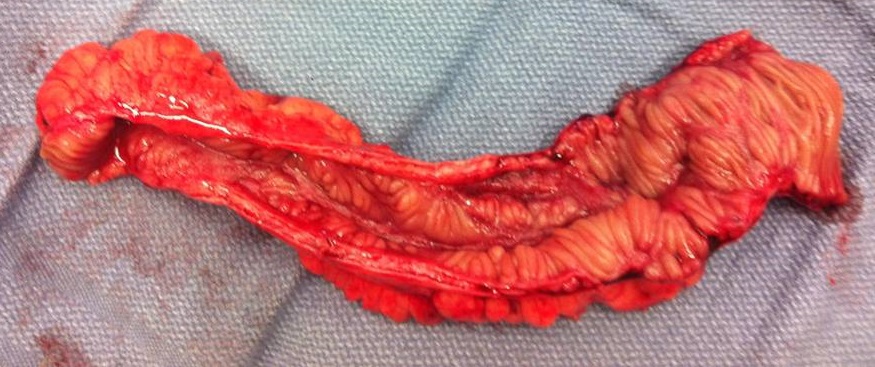Short bowel syndrome pathophysiology: Difference between revisions
| Line 35: | Line 35: | ||
===Physiology=== | ===Physiology=== | ||
The [[small intestine]] has an average length of 5.5-6 meter and is responsible for absorbing [[nutrients]]. Absorption mostly occurs in [[duodenum]], [[jejunum]], and [[ileum]]. There is an anatomic gradient for [[absorption]] throughout the [[gastrointestinal tract]].<ref name="pmid24500909">{{cite journal |vauthors=Tappenden KA |title=Pathophysiology of short bowel syndrome: considerations of resected and residual anatomy |journal=JPEN J Parenter Enteral Nutr |volume=38 |issue=1 Suppl |pages=14S–22S |year=2014 |pmid=24500909 |doi=10.1177/0148607113520005 |url=}}</ref> | The [[small intestine]] has an average length of 5.5-6 meter and is responsible for absorbing [[nutrients]]. Absorption mostly occurs in [[duodenum]], [[jejunum]], and [[ileum]]. There is an anatomic gradient for [[absorption]] throughout the [[gastrointestinal tract]].<ref name="pmid24500909">{{cite journal |vauthors=Tappenden KA |title=Pathophysiology of short bowel syndrome: considerations of resected and residual anatomy |journal=JPEN J Parenter Enteral Nutr |volume=38 |issue=1 Suppl |pages=14S–22S |year=2014 |pmid=24500909 |doi=10.1177/0148607113520005 |url=}}</ref> | ||
[[image:Diagram of the small bowel 01 CRUK 045.jpg | {| align="right" | ||
| | |||
[[image:Diagram of the small bowel 01 CRUK 045.jpg|thumb|300px|Diagram of the small bowel 01. Source: Wikimedia.org By Cancer Research UK - Original email from CRUK, CC BY-SA 4.0,<ref name="urlFile:Diagram of the small bowel 01 CRUK 045.svg - Wikimedia Commons">{{cite web |url=https://commons.wikimedia.org/w/index.php?curid=34332940 |title=File:Diagram of the small bowel 01 CRUK 045.svg - Wikimedia Commons |format= |work= |accessdate=}}</ref>]] | |||
|} | |||
<br style="clear:right" /> | <br style="clear:right" /> | ||
*The [[duodenum]], first portion of [[small intestine]], is responsible for the breakdown of food in the [[small intestine]]. [[Brunner's glands]], which secrete [[mucus]], are found in the duodenum. | *The [[duodenum]], first portion of [[small intestine]], is responsible for the breakdown of food in the [[small intestine]]. [[Brunner's glands]], which secrete [[mucus]], are found in the duodenum. | ||
Revision as of 16:40, 5 December 2017
|
Short bowel syndrome Microchapters |
|
Diagnosis |
|---|
|
Treatment |
|
Case Studies |
|
Short bowel syndrome pathophysiology On the Web |
|
American Roentgen Ray Society Images of Short bowel syndrome pathophysiology |
|
Risk calculators and risk factors for Short bowel syndrome pathophysiology |
Editor-In-Chief: C. Michael Gibson, M.S., M.D. [1]; Associate Editor(s)-in-Chief: Sadaf Sharfaei M.D.[2]
Overview
The exact pathogenesis of [disease name] is not fully understood.
OR
It is thought that [disease name] is the result of / is mediated by / is produced by / is caused by either [hypothesis 1], [hypothesis 2], or [hypothesis 3].
OR
[Pathogen name] is usually transmitted via the [transmission route] route to the human host.
OR
Following transmission/ingestion, the [pathogen] uses the [entry site] to invade the [cell name] cell.
OR
[Disease or malignancy name] arises from [cell name]s, which are [cell type] cells that are normally involved in [function of cells].
OR
The progression to [disease name] usually involves the [molecular pathway].
OR
The pathophysiology of [disease/malignancy] depends on the histological subtype.
Pathophysiology
Physiology
The small intestine has an average length of 5.5-6 meter and is responsible for absorbing nutrients. Absorption mostly occurs in duodenum, jejunum, and ileum. There is an anatomic gradient for absorption throughout the gastrointestinal tract.[1]
 |
- The duodenum, first portion of small intestine, is responsible for the breakdown of food in the small intestine. Brunner's glands, which secrete mucus, are found in the duodenum.
- The jejunum, second portion of small intestine, is responsible to absorb nutrients. The inner surface of the jejunum is covered in villi, which increase the surface area of tissue available to absorb nutrients from the gut contents. The villi in the jejunum are much longer than in the duodenum or ileum. It has many large circular folds in its submucosa called plicae circulares, which increase the surface area for nutrient absorption.
- The ileum, third portion of small intestine, is responsible to absorb vitamin B12 and bile salts and whatever products of digestion that were not absorbed by the jejunum. Its surface is made up of folds, mainly villi and microvilli. Therefore the ileum has an extremely large surface area both for the adsorption (attachment) of enzyme molecules and for the absorption of products of digestion. The DNES (diffuse neuroendocrine system)cells that line the ileum contain the protease and carbohydrase enzymes (gastrin, secretin, cholecystokinin) responsible for the final stages of protein and carbohydrate digestion.
Pathogenesis
- The exact pathogenesis of [disease name] is not fully understood.
OR
- It is thought that [disease name] is the result of / is mediated by / is produced by / is caused by either [hypothesis 1], [hypothesis 2], or [hypothesis 3].
- [Pathogen name] is usually transmitted via the [transmission route] route to the human host.
- Following transmission/ingestion, the [pathogen] uses the [entry site] to invade the [cell name] cell.
- [Disease or malignancy name] arises from [cell name]s, which are [cell type] cells that are normally involved in [function of cells].
- The progression to [disease name] usually involves the [molecular pathway].
- The pathophysiology of [disease/malignancy] depends on the histological subtype.
Associated Conditions
Gross Pathology
- On gross pathology, the resected bowel may show the underlying causes including Crohn's disease, malignancies or ischemia.
 |
 |
Microscopic Pathology
- On microscopic histopathological analysis, the resected bowel may show the underlying causes including Crohn's disease, malignancies or ischemia.
References
- ↑ Tappenden KA (2014). "Pathophysiology of short bowel syndrome: considerations of resected and residual anatomy". JPEN J Parenter Enteral Nutr. 38 (1 Suppl): 14S–22S. doi:10.1177/0148607113520005. PMID 24500909.
- ↑ "File:Diagram of the small bowel 01 CRUK 045.svg - Wikimedia Commons".
- ↑ "File:ResectedIleum.jpg - Wikimedia Commons". External link in
|title=(help) - ↑ "File:Crohn Jejunum.PNG - Wikimedia Commons".